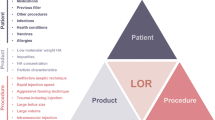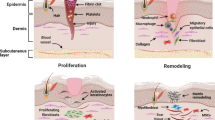Abstract
This double blind controlled study examined whether oxygen-derived free radicals interfere with the healing of venous ulceration occurring on the medial side of the leg for the first time. Graduated compression bandages exerting a mean ankle pressure of 42.1±0.3 mmHg and a mean pressure of 17.3±0.2 mmHg just below the knee healed 70% of ulcers within 12 weeks (n=44). Addition of the radical scavengers allopurinol (n=45) or dimethyl sulfoxide (n=44) to the compression bandages (daily application of the powder for 7 days, then once weekly applications to the end of the study at 3 months) significantly (p < 0.01) stimulated the healing of venous ulceration relative to controls when studied 4, 8, and 12 weeks after commencing treatment. After 3 months of treatment, allopurinol healed 93% and dimethyl sulfoxide healed 95% of the venous ulcers. The results suggest that oxygen-derived free radicals are directly implicated in the mechanism of venous ulceration and are responsible for its persistence. Scavenging such radicals stimulates the healing of ulceration.
Résumé
Cette étude contrôlée en double aveugle a cherché à déterminer si les radicaux libres à oxygène jouaient un rôle bénéfique sur la cicatrisation de l'ulcère variqueux primitif localisé sur la face interne de la jambe. Un bandage compressif gradué exerçant une pression moyenne de 42.1±0.3 mm Hg au niveau de la cheville et une pression moyenne de 17.3±0.2 mm Hg juste sous le genou a permis la guérison de 70% des ulcères en 12 semaines (n=44). Le fait d'ajouter des radicaux d'allopurinol (n=45) ou de sulfoxyde de diméthyl (n=44) au bandage compressif (application quotidienne de poudre pendant 7 jours, puis une application une fois par semaine jusqu'à la fin de l'étude à quatre mois) augmente de façon significative (p<0.01) la cicatrisation de l'ulcère variqueux en comparaison des contrôles à 4, 8, et à 12 semaines après le début du traitement. Après 3 mois de traitement, l'allopurinol a guéri 93% des ulcères variqueux et le diméthyl sulfoxyde en a guéri 95%. Ces résultats suggèrent que les radicaux libres à oxygène sont directement impliqués dans le mécanisme de l'ulcère variqueux et sont responsables de leur persistance. Eliminer ces radicaux stimule la cicatrisation de l'ulcération.
Resumen
El presente estudio doble ciego controlado fue diseñado para investigar si los radicales libres derivados del oxígeno interfieren con la cicatrización de ulceraciones venosas que se presentan por primera vez sobre el aspecto interno de la pierna. El uso de vendas de compresión graduada que ejercen una presión media sobre el tobillo de 42.1±0.3 mm Hg y una presión media de 17.3±0.2 mm Hg justo por debajo de la rodilla, resultó en la cicatrizatión de 70% de las úlceras en un período menor de 12 semanas (n=44). La adición de los depuradores de radicales libres, alopurinol (n=45) o sulfóxido de metilo (n=44) a la venda compresiva (aplicación diaria del polvo por 7 días y luego aplicación semanal hasta el final del estudio a los 3 meses) estimuló en forma significativa (p<0.01) la cicatrizatión de las úlceras venosas en comparación con los controles, según estudios a las 4, 8, y 12 semanas de iniciado el tratamiento. Después de 3 meses de tratamiento, el alopurinol cicatrizó 93% y el sulfóxido de metilo 95% de las úlceras venosas. Los resultados sugieren que los radicales libres derivados del oxíogeno se hallan directamente comprometidos en el mecanismo de la ulceratión venosa y que son responsables de su persistencia. La depuration de tales radicales estimula la cicatrizatión de la ulceratión.
Similar content being viewed by others
References
Warren, R., White, E.A., Belcher, C.B.: Venous pressure in the saphenous system in normal, varicose and post-phlebitic extremities. Surgery26:435, 1949
Negus, D.: The post-thrombotic syndrome. Ann. Roy. Coll. Surg. Engl.47:92, 1970
Browse, N.L., Burnand, K.G.: The cause of venous ulceration. Lancet2:243, 1982
Corwall, J.V., Doré, C.J., Lewis, J.D.: Leg ulcers: Epidemiology and aetiology. Br. J. Surg.73:693, 1986
Coleridge Smith, P.D., Thomas, P., Scurr, J.H., Dormandy, J.A.: Causes of venous ulceration: A new hypothesis. Br. Med. J.296:1726, 1988
Mani, R., White, J.E., Barrett, D.F., Weaver, P.W.: Tissue oxygenation, venous ulcers and fibrin cuffs. J. Roy. Soc. Med.82:345, 1989
Itoh, M., Guth, P.: Role of oxygen-derived free radicals in hemorrhagic shock-induced gastric lesions in the rat. Gastroenterology88:1162, 1985
Salim, A.S.: Role of oxygen-derived free radicals in the mechanism of chronic gastric ulceration in the rat. Implications for cytoprotection. Digestion43:113, 1989
Parks, D.A., Bulkley, G.B., Granger, D.N., Hamilton, S.R., McCord, J.M.: Ischemic injury in the cat small intestine: Role of Superoxide radicals. Gastroenterology82:9, 1982
Granger, D.N., Rutili, G., McCord, J.M.: Superoxide radicals in feline intestinal ischemia. Gastroenterology81:22, 1981
Parks, D.A., Granger, D.N.: Ischemia-induced microvascular changes; Role of xanthine oxidase and hydroxyl radicals. Am. J. Physiol.245:G285, 1983
Negus, D., Friedgood, A.: The effective management of venous ulceration. Br. J. Surg.70:623, 1983
Stemmer, R.: Ambulatory elasto-compressive treatment for the lower extremities particularly with elastic stockings. Der Kassenarzt9:1, 1969
Backhouse, C.M., Blair, S.D., Savage, A.P., Jackie Walton, McCollum, C.N.: Controlled trial of occlusive dressings in healing chronic venous ulcers. Br. J. Surg.74:626, 1987
Moorhouse, P.C., Grootveld, M., Halliwell, B., Quinlan, J.G., Gutteridge, J.M.C.: Allopurinol and oxypurinol are hydroxyl radical scavengers. F.E.B.S. Letts.213:23, 1987
Author information
Authors and Affiliations
Rights and permissions
About this article
Cite this article
Salim, A.S. The role of oxygen-derived free radicals in the management of venous (varicose) ulceration: A new approach. World J. Surg. 15, 264–269 (1991). https://doi.org/10.1007/BF01659062
Issue Date:
DOI: https://doi.org/10.1007/BF01659062




